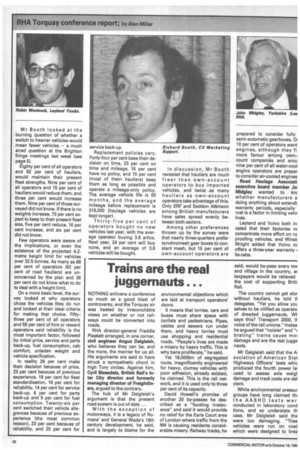Trains are the real juggernauts . .
Page 22

Page 23

If you've noticed an error in this article please click here to report it so we can fix it.
NOTHING enlivens a conference so much as a good blast of controversy, and the Torquay air was heated by irreconcilable views on whether or not railways could be converted into roads.
RHA director-general Freddie Plaskett arranged, in one corner, civil engineer Angus Dalgleish, who believes they can be, and the more, the merrier for us all. His arguments are said to have struck a sympathetic chord in high Tory circles. Against him, Cyril Bleasdale, British Rail's Inter City director and formerly managing director of Freightliners, argued to the contrary.
The hub of Mr Dalgleish's argument is that the present road system is out of date ...
With the exception of motorways, it is a legacy of Romans' and General Wade's 18th century development, he said, and is largely to blame for the environmental objections which are laid at transport operators' doors.
It means that lorries, cars and buses must share space with cyclists and pedestrians. Pipes, cables and sewers run under them, and heavy lorries must use shopping and residential roads. "People's lives are made a misery by heavy traffic. This is why bans proliferate," he said.
Yet 18,000km of segregated route, magnificently engineered for heavy, clumsy vehicles with poor adhesion, already existed, he claimed. This is the rail network, and it is used only to three per cent of its capacity.
David Howell's promise of another 20 by-passes he described as a "footling irrelevance" and said it would provide no relief for the Earls Court area of London where traffic from the M4 is causing residents considerable misery. Railway tracks, he said, would by-pass every toy and vfllage in the country, ar taxpayers would be relieved the cost of supporting Briti: Rail.
The country cannot get alor without hauliers, he told ti delegates. "Yet you allow you selves to be vilified as operato of dreaded juggernauts. Wt says this? Transport 2000, tt voice of the rail unions." Instea he argued that "noisier" and "NI brating" trains cause moi damage and are the real jugge nauts.
Mr Dalgleish said that the A! sociation of American Stat Highways Officers' tests whic produced the fourth power lel used to assess axle weigl damage and track costs are clef cient.
While environmental pressur groups have long claimed thi the AASHO tests wer conducted in laboratory cond tions, and so understate th case, Mr Dalgleish said the were too damaging. "Thes vehicles were run on road which were designed to brea reasonably quickly under the ids imposed. If you run on ads with a pavement depth depled so that the road does not eak up, the effects might be fferent."
In any case, he said, BR's iight services pay only the un'oidable costs attributed to em, and are subsidised by the issenger network which, in irn, is subsidised by the xpayer to the tune of 40 per tnt.
In addition, there are subsidies r sidings, the "lost pension nd," and BR pays little fuel tax. acks costs, he said, were not aing calculated fairly.
Mr Dalgleish illustrated his ise with slides showing where Dandoned railways have been )nverted into roads, drawing. articular attention to the testern Approach road in Edinurgh which has graded juncons and uses abandoned rail ridges. He contrasted this with xamples of a few narrow ridges in the Home Counties there existing roads present lajor difficulties.
Using drawings — not photoraphs — he claimed that existig tunnels and bridges already irovide satisfactory clearance Dr single carriageway two-lane clads to be built on existing railrack bed.
Mr Bleasdale took issue with Dalgleish's argument that ailways make insufficient use of their track, and said that rail carries 10 per cent of the combined freight and passenger traffic in Britain on only five per cent of the total road/rail track kilometrage in the country.
There is no economic justification for concreting over existing railways, said Mr Bealsdale, and he questioned where, for instance, road vehicles would be accommodated, if they ran on rail routes into London. There would not be space in the existing rail termini.
Mr Bleasdale produced figures to back his claim that railways are more energy efficient than roads, being twice as efficient as cars and five times as efficient as coaches, on BR's calculations. He said there is a strong case for investing North Sea oil revenue in projects like rail electrification as this will help replace existing dependence on finite energy supplies.
Rail, he said, is safer — contradicting Mr Dalgleish's earlier claim — and quieter. It also causes much less pollution.
Dealing specifically with Mr Dalgleish's claims, Mr Bleasdale said that the costs and difficulties of conversion have consistently been under-estimated, at least by a factor of 10, and possibly 40 in some cases. Ballast would need to be removed from rail routes and tarmac surfaces engineered in. Entirely new drainage would be needed, road bridges would need to be raised and tunnels would need to be ventilated, illuminated and enlarged.
He pointed out that BR's vehicles have a 4m height limit




















































































